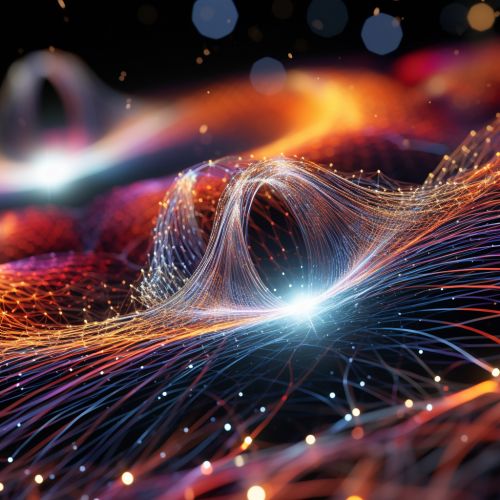Quantum Entanglement in Many-Body Systems
Introduction
Quantum entanglement is a physical phenomenon that occurs when pairs or groups of particles interact in ways such that the quantum state of each particle cannot be described independently of the state of the other(s), even when the particles are separated by a large distance. This phenomenon is one of the peculiarities of quantum mechanics, and it is at the heart of many-body systems, which are systems composed of a large number of interacting particles.


Quantum Entanglement
Quantum entanglement is a fundamental concept in quantum mechanics, a branch of physics that describes the behavior of particles at the smallest scales. It is a phenomenon that defies our classical understanding of the world and has been described as "spooky action at a distance" by Albert Einstein. However, despite its counterintuitive nature, quantum entanglement has been experimentally confirmed and is now a cornerstone of modern quantum theory.
The concept of entanglement arises from the superposition principle in quantum mechanics, which states that a physical system—such as a particle—can exist in multiple states at once. When two particles are entangled, the state of one particle is directly related to the state of the other, no matter how far apart they are. This means that a change in the state of one particle will instantaneously affect the state of the other, a phenomenon that Einstein famously criticized as being incompatible with the theory of relativity.
Many-Body Systems
Many-body systems are physical systems that consist of a large number of interacting particles. These systems are prevalent in nature and include, for example, solid-state systems, atomic and molecular systems, and nuclear systems. The complexity of many-body systems arises from the interactions between the particles, which can lead to emergent phenomena that are not present in the individual particles themselves.
In quantum mechanics, many-body systems are typically described by a wave function, which provides a complete description of the system's state. However, due to the large number of particles and interactions, solving the wave function of a many-body system is a formidable task. This is known as the many-body problem, and it remains one of the most challenging problems in physics.
Quantum Entanglement in Many-Body Systems
Quantum entanglement plays a crucial role in many-body systems. In fact, it is the source of many of the complex and fascinating behaviors of these systems. For instance, entanglement is responsible for the phenomenon of quantum phase transitions, which are transitions between different phases of matter at zero temperature. Moreover, entanglement is also at the heart of quantum critical phenomena, which are characterized by long-range correlations and scale invariance.
In addition, quantum entanglement in many-body systems is a key resource for quantum information processing and quantum computing. For example, the ability to generate and manipulate entangled states in many-body systems is essential for the implementation of quantum algorithms and protocols.
Despite its importance, understanding and characterizing entanglement in many-body systems is a challenging task. This is due to the exponential growth of the complexity of the system with the number of particles. However, significant progress has been made in recent years, thanks to the development of new theoretical tools and numerical methods, as well as advances in experimental techniques.
Theoretical Approaches
Several theoretical approaches have been developed to study quantum entanglement in many-body systems. These include, for instance, the density matrix renormalization group (DMRG) method, which is a powerful numerical technique for studying one-dimensional many-body systems. Another important approach is the use of tensor network states, which provide a versatile framework for describing entangled states in many-body systems.
Furthermore, the concept of entanglement entropy has proven to be a valuable tool for characterizing entanglement in many-body systems. Entanglement entropy quantifies the amount of entanglement between a subsystem and the rest of the system. It has been shown to provide important insights into the structure of the entangled states and the nature of quantum phase transitions.
Experimental Realizations
Experimental realization of quantum entanglement in many-body systems is a challenging task. However, significant progress has been made in recent years, thanks to advances in experimental techniques. For instance, entanglement has been observed in systems of ultracold atoms, where the interactions between the atoms can be precisely controlled. Moreover, entanglement has also been demonstrated in solid-state systems, such as superconductors and quantum magnets.
These experimental realizations have not only confirmed the theoretical predictions but also opened up new possibilities for exploring the rich physics of entangled many-body systems. Moreover, they have paved the way for the development of quantum technologies, such as quantum computers and quantum communication networks.
Conclusion
Quantum entanglement in many-body systems is a fascinating and complex phenomenon. It is at the heart of many of the intriguing behaviors of these systems and holds great promise for quantum technologies. Despite the challenges, significant progress has been made in understanding and characterizing entanglement in many-body systems, thanks to the development of new theoretical tools and experimental techniques. However, much remains to be explored, and the study of quantum entanglement in many-body systems continues to be a vibrant and active area of research.
